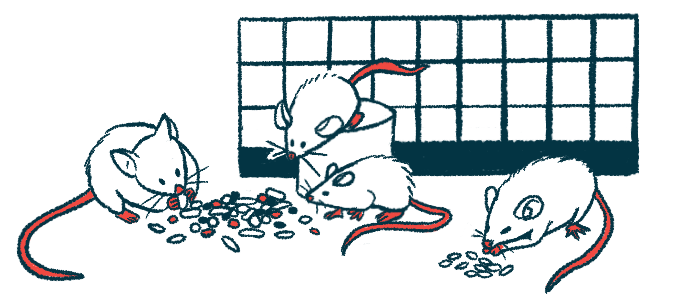Linoleic acid found to ease movement, balance in AS mice
Fatty acid in seed oils may help as treatment for Angelman syndrome
Written by |

Linoleic acid, a fatty acid commonly found in seed oils, eased movement and balance problems in a mouse model of Angelman syndrome (AS), a study reported.
AS mice fed a diet enriched with linoleic acid were found to have enhanced activity of PIEZO2, a protein channel found in nerve cell membranes that helps mediate coordination and balance.
According to researchers, these findings suggest that PIEZO2 may be a therapeutic target for Angelman and provide proof of concept that increasing dietary linoleic acid may treat movement and balance problems in AS.
“A linoleic acid (LA)-enriched diet increases PIEZO2 activity … and improves gait in male AS mice,” the team wrote.
The mouse study, “Linoleic acid improves PIEZO2 dysfunction in a mouse model of Angelman Syndrome,” was published in the journal Nature Communications.
Focus on diet as a potential new treatment for Angelman sydrome
In AS, genetic defects result in a missing or malfunctioning UBE3A, an enzyme that helps maintain the balance of protein in neurons (nerve cells) in the brain. Without UBE3A, some neurons malfunction and give rise to a range of symptoms, including intellectual deficits and physical disabilities.
Almost all Angelman patients develop problems with movement and balance, specifically impaired balance or coordination, referred to as ataxia. Such symptoms result from a UBE3A deficiency in the cerebellum, the structure at the back and base of the brain that’s mainly responsible for motor control.
However, a lack of UBE3A in the cerebellum does not fully explain the ataxic gait and poor balance seen in AS.
UBE3A also is produced in the dorsal root ganglia (DRG) neurons, a group of nerve cells adjacent to the spinal cord, which send nerve fibers throughout the skin, organs, muscles, and bone. DRGs are sensory neurons that participate in proprioception, the sense of body movement and position — also sometimes called the sixth sense.
Researchers based at the University of Tennessee Health Science Center and their collaborators thought that a loss of UBE3A in DRG sensory neurons might contribute to ataxia in AS.
To find out, the team focused on PIEZO2, a protein in neuron cell membranes that regulates coordination and balance by responding to mechanical input, such as body movement.
PIEZO2 deficiency in humans and mouse models impairs proprioception, leading to sensory ataxia — a form of ataxia caused not by an impaired cerebellum but by loss of sensory input to help control body movements.
Initial experiments confirmed that DRG neurons from mice deficient in UBE3A had reduced PIEZO2 activity. Similar findings were seen in human Merkel cells, which are sensory neurons in the skin that also produce PIEZO2 and respond to physical touch.
Likewise, PIEZO2 activity was decreased in human sensory neurons derived from stem cells with suppressed UBE3A activity, and in stem cell-derived neurons from AS patients. Overall, a lack of UBE3A reduced PIEZO2 function.
The team had previously shown that the function of PIEZO1, a protein almost identical to PIEZO2, was enhanced in cell membranes containing high levels of linoleic acid, a fatty acid commonly found in safflower, sunflower, soybean, corn, and canola oils.
Here, neurons incubated with linoleic acid enhanced the activity of PIEZO2. Further experiments demonstrated that linoleic acid increased PIEZO2 function by increasing cell membrane fluidity rather than increasing PIEZO2 production or directly interacting with the PIEZO2 protein.
Our results demonstrate that PIEZO2 is a therapeutic target for AS and provide proof of concept that increasing [linoleic acid] in the diet enhances channel activity and ameliorates gait ataxia in a mouse model of AS.
AS mice fed a diet enriched in safflower oil — which contains more than 70% linoleic acid — had about twice the levels of the acid in their cell membranes compared with normal or AS mice not fed this diet. Consistently, the linoleic acid-enriched diet increased DRG signals, including those from PIEZO2, in AS mice.
Normal mice fed a linoleic acid-enriched diet also had increased PIEZO2 activity. Furthermore, the linoleic acid diet did not affect body weight, showed no immune activation, and did not enhance nociception, or sensory responses to tissue injury or heat. These findings indicate that the “safflower oil-enriched diet does not induce inflammation,” the researchers wrote.
Finally, in gait experiments, feeding AS mice with a linoleic acid-enriched diet restored their stride length and number of steps to levels seen in healthy mice, whereas this diet did not affect healthy mice. The team showed that linoleic acid, rather than a high caloric intake, eased gait ataxia in AS mice.
The researchers noted that, despite these findings, their work “does not rule out that the effect of [linoleic acid] on behavior could occur somewhere else beyond solely increasing PIEZO2 function in DRG neurons.”
“Our results demonstrate that PIEZO2 is a therapeutic target for AS and provide proof of concept that increasing [linoleic acid] in the diet enhances channel activity and ameliorates gait ataxia in a mouse model of AS,” the team wrote.






